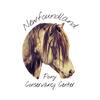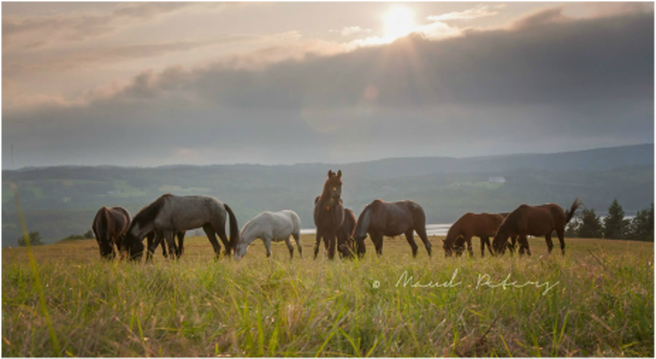The Equus Survival Trust lists the Newfoundland Pony as critically endangered,
with fewer than 500 in the world and fewer than 50 in the USA,
over half of which are under our umbrella of protection in our Newfoundland Pony network.
with fewer than 500 in the world and fewer than 50 in the USA,
over half of which are under our umbrella of protection in our Newfoundland Pony network.
Photo credit and copyright - Maud Peters, 2014.
Newfoundland Pony Facts
The typical Newfoundland Pony:
What are Newfoundland Ponies used for? Anything and everything. They can work the garden, haul your firewood, pull a cart or a sleigh, and take the kids out for trail ride, all while being your best friend. They are the pony you'll never outgrow.™
The Newfoundland Pony is often referred to as the "Poor Man's Horse" - we prefer to think of it as "economic". These ponies thrive as backyard ponies. They are multi-purpose, and can do anything. Oh, and did we mention some of them even like boat rides?
Video credit to Twillingate Tours: This is our stallion Ammy's full brother. This is what we mean when we say the pony has adapted to life in Newfoundland. Can you imagine any other pony or horse hopping into a boat like that?
The typical Newfoundland Pony:
- Weighs between 400 and 800 pounds, and stands 11 hands to 14.2 hands. They have thick manes and very thick coats in the winter.
- Their characteristic low-set tails allow snow to shed more easily.
- Their distinct narrow chests allow for better cooling and warming.
- Close set front legs make them agile and sturdy on the rocky ground and able to navigate tight spaces.
- Their hooves are hard and slow growing.
- Short, furry, thick ears are more frostbite resistant and the hooding over their eyes protects them from rain, ice and snow.
- Commonly brownish in color, other colors such as blue roan, grey, chestnut, black and bay are found.
- Some ponies are mild to drastic color changers, changing colors from season to season. Examples include appearing black during the winter and blue roan in the summer, or chestnut in winter and red roan in summer.
What are Newfoundland Ponies used for? Anything and everything. They can work the garden, haul your firewood, pull a cart or a sleigh, and take the kids out for trail ride, all while being your best friend. They are the pony you'll never outgrow.™
The Newfoundland Pony is often referred to as the "Poor Man's Horse" - we prefer to think of it as "economic". These ponies thrive as backyard ponies. They are multi-purpose, and can do anything. Oh, and did we mention some of them even like boat rides?
Video credit to Twillingate Tours: This is our stallion Ammy's full brother. This is what we mean when we say the pony has adapted to life in Newfoundland. Can you imagine any other pony or horse hopping into a boat like that?
Newfoundland Ponies Are:
- Hardy - capable of hard work as well as play, Newfoundland Ponies are used for anything from pulling heavy loads, to handling both adult and child riders.
- Friendly and curious - they want to be where you are, doing what you're doing, and hey - what's that in your pocket?
- Docile and social (including the stallions) - they are often said to be more dog-like in their personality.
- Healthy - no known genetic diseases or defects are carried by the breed.
- Easy keepers - they don't require grain unless underweight, thriving on pasture and first cut hay through a slow feeder.
- Extremely smart and easily trained - they like to puzzle through things, are always eager to learn something new, and don't forget training easily.
Now here's the cool part: the Newfoundland Pony has no known genetic defects. How awesome is that? It means that they don't have the modern day equine's struggles with PSSM, HYPP, LFS, OLWS, or any other inheritable diseases. This is why the Newfoundland Pony Conservancy Center, along with Newfoundland Pony Society and and other Newfoundland enthusiasts, are trying hard to save the Pony from extinction. While we currently discourage cross breeding using the mares, our hope is to one day return the Pony's numbers to their previous population of several thousand, and when we do, the Newfoundland's healthy genetics can be used to help other breeds stabilize. Newfoundland crosses retain their healthier genes and are generally good-natured, healthy, sturdy and intelligent horses.
Also "inside" is a very diverse base of genetics, carried forward from their ancestors - Exmoor, Dartmoor, Kerry Bog, Eriskay, New Forest, Scottish Galloway (extinct), Dales, Highland, Fell, Connemara, and Welsh Mountain. The Newfoundland Pony is a four-legged time capsule of antique genetics, having not had their genetics manipulated by people as the majority of their ancestors did. Most of those breeds are not the same today as they were during the Newfoundland Pony's creation. People changed these ancestral breeds by adding outside blood to their gene pools to make them suit human needs as horses became less essential to day to day life, and more of a luxury. Some of those "improvements" also unknowingly added undesirable traits and health issues to those breeds - such as the American Cream Draft's introduction of the junctional epidermolysis bullosa gene, or "JEB" - also known as "Hairless Foal Syndrome" or "Red Foot Disease". In a large population of horses, introduction of lethal genes are unfortunate, but in a small group like the Newfoundland and the American Cream, it is disastrous. With so few left, we cannot risk the introduction of any life threatening addition to their gene pool.
Newfoundland Pony Rescue - is not just about saving an individual pony, rescue in this case is saving the entire breed. But every pony counts.
Learn more about Newfoundland Pony History
Newfoundland Pony Documentary
Newfoundland Pony Documentary

